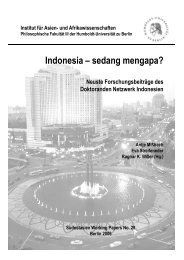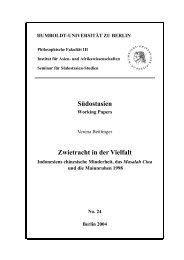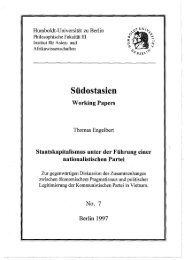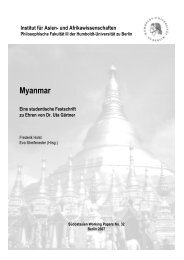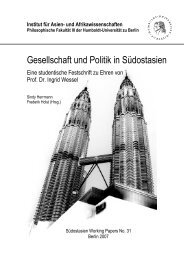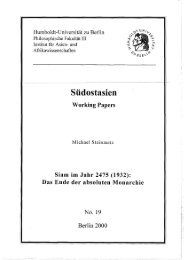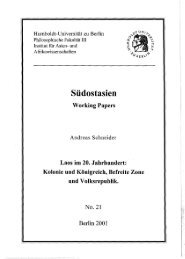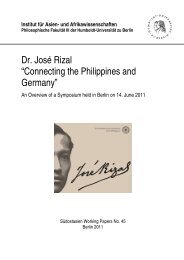On Centrism and Dualism - Humboldt-Universität zu Berlin
On Centrism and Dualism - Humboldt-Universität zu Berlin
On Centrism and Dualism - Humboldt-Universität zu Berlin
Create successful ePaper yourself
Turn your PDF publications into a flip-book with our unique Google optimized e-Paper software.
CENTRISM AND DUALISM<br />
Rol<strong>and</strong> HARDENBERG (2007) remarks that even though the weak points of the classic theories<br />
were exposed <strong>and</strong> hence the necessity for new models <strong>and</strong> intensive research highlighted, the<br />
anthropological field of kinship studies was shaken by this continuous <strong>and</strong> fundamental<br />
criticism. 60 Modernization <strong>and</strong> globalization became the new anthropological focus <strong>and</strong> the<br />
scholars were looking for alternative models. As a result, kinship studies vanished from the<br />
anthropological curricula in many countries. In this time of rapid change, accompanied by the<br />
expansion of bureaucratic <strong>and</strong> capitalistic cultures, the classic models of kinship studies were<br />
refuted as representing perspectives that were too static <strong>and</strong> inflexible (ibid.: 161-162).<br />
According to Susan GILLESPIE (GILLESPIE 2000a), the epistemological shift away from the<br />
classic concepts of kinship studies contributed to the revelation that in many societies the<br />
indigenous word for ‘house’ also refers to a group of people associated with some spatial<br />
locus, one that most often includes a dwelling or other structure. In practical discourse <strong>and</strong><br />
action the house may represent social, economic, political <strong>and</strong> ritual relationships among<br />
various persons, who may form a permanent or temporary collectivity (ibid.:6). As a<br />
consequence the symbolism of domestic houses had received a fair amount of anthropological<br />
attention (e.g. NEEDHAM 1962; CUNNINGHAM 1973 [1964]; TAMBIAH 1969; BLOCH 1971;<br />
61<br />
BOURDIEU 1977).<br />
BOURDIEU’S statements made with reference to his analysis of the Kabyle house, in his book<br />
Outline of a Theory of Practice (BOURDIEU 1977), represent a paradigmatic example of how<br />
the classic anthropological perspectives were becoming criticized on grounds of an increased<br />
attention directed towards the house. In highlighting the significance of the house as an<br />
indigenous concept to convey meaning, BOURDIEU questions the appropriateness of analytic<br />
categories that were understood as universals on the one h<strong>and</strong>, <strong>and</strong> on the other h<strong>and</strong> he<br />
emphasizes the body as an agent in the process of decoding cultural messages. With his<br />
60 “To put it very bluntly, then, there is no such thing as kinship, <strong>and</strong> it follows that there can be no such thing as<br />
kinship theory.” (NEEDHAM 1971: 5)<br />
61 “In a social formation in which the absence of the symbolic-product-conserving techniques associated with<br />
literacy retards the objectification of symbolic <strong>and</strong> particularly cultural capital, inhabited space – <strong>and</strong> above all<br />
the house – is the principal locus for the objectification of the generative schemes; <strong>and</strong>, through the intermediary<br />
of the divisions <strong>and</strong> hierarchies it sets up between things, persons, <strong>and</strong> practices, this tangible classifying system<br />
continuously inculcates <strong>and</strong> reinforces the taxonomic principles underlying the arbitrary provisions of this<br />
culture. […] This analysis of the relationship between the objectified schemes <strong>and</strong> the schemes incorporated or<br />
being incorporated presupposes a structural analysis of the social organization of the internal space of the house<br />
<strong>and</strong> the relation of this internal space to the external space, an analysis which is not an end in itself but which,<br />
precisely on account of the (dangerous) affinity between objectivism <strong>and</strong> all that is already objectified, is the<br />
only means of fully grasping the structuring structures which, remaining obscure to themselves, are revealed<br />
only in the objects they structure. The house, an opus operatum, lends itself as such to a deciphering, but only to<br />
a deciphering which does not forget that the “book” from which the children learn their vision of the world is<br />
read with the body, in <strong>and</strong> through the movements <strong>and</strong> displacements which make the space within which they<br />
are enacted as much as they are made by it.” (BOURDIEU 1977: 89-90 original italics)<br />
32



